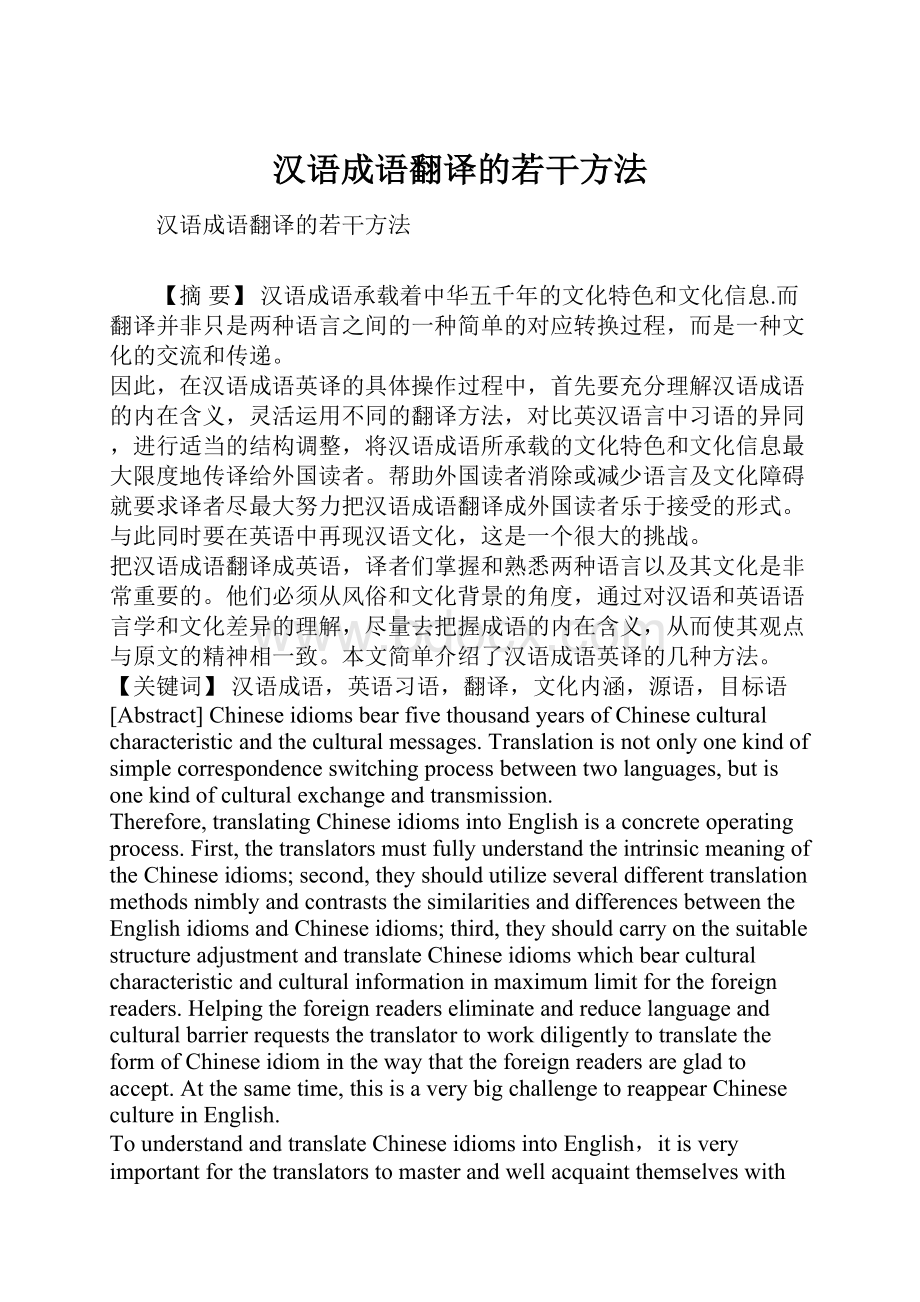汉语成语翻译的若干方法.docx
《汉语成语翻译的若干方法.docx》由会员分享,可在线阅读,更多相关《汉语成语翻译的若干方法.docx(14页珍藏版)》请在冰豆网上搜索。

汉语成语翻译的若干方法
汉语成语翻译的若干方法
【摘要】汉语成语承载着中华五千年的文化特色和文化信息.而翻译并非只是两种语言之间的一种简单的对应转换过程,而是一种文化的交流和传递。
因此,在汉语成语英译的具体操作过程中,首先要充分理解汉语成语的内在含义,灵活运用不同的翻译方法,对比英汉语言中习语的异同,进行适当的结构调整,将汉语成语所承载的文化特色和文化信息最大限度地传译给外国读者。
帮助外国读者消除或减少语言及文化障碍就要求译者尽最大努力把汉语成语翻译成外国读者乐于接受的形式。
与此同时要在英语中再现汉语文化,这是一个很大的挑战。
把汉语成语翻译成英语,译者们掌握和熟悉两种语言以及其文化是非常重要的。
他们必须从风俗和文化背景的角度,通过对汉语和英语语言学和文化差异的理解,尽量去把握成语的内在含义,从而使其观点与原文的精神相一致。
本文简单介绍了汉语成语英译的几种方法。
【关键词】汉语成语,英语习语,翻译,文化内涵,源语,目标语
[Abstract]ChineseidiomsbearfivethousandyearsofChineseculturalcharacteristicandtheculturalmessages.Translationisnotonlyonekindofsimplecorrespondenceswitchingprocessbetweentwolanguages,butisonekindofculturalexchangeandtransmission.
Therefore,translatingChineseidiomsintoEnglishisaconcreteoperatingprocess.First,thetranslatorsmustfullyunderstandtheintrinsicmeaningoftheChineseidioms;second,theyshouldutilizeseveraldifferenttranslationmethodsnimblyandcontraststhesimilaritiesanddifferencesbetweentheEnglishidiomsandChineseidioms;third,theyshouldcarryonthesuitablestructureadjustmentandtranslateChineseidiomswhichbearculturalcharacteristicandculturalinformationinmaximumlimitfortheforeignreaders.HelpingtheforeignreaderseliminateandreducelanguageandculturalbarrierrequeststhetranslatortoworkdiligentlytotranslatetheformofChineseidiominthewaythattheforeignreadersaregladtoaccept.Atthesametime,thisisaverybigchallengetoreappearChinesecultureinEnglish.
TounderstandandtranslateChineseidiomsintoEnglish,itisveryimportantforthetranslatorstomasterandwellacquaintthemselveswiththeoriginallanguageandthetargetlanguageandtheircultures.TheyshouldsetoutfromtheaspectsofcustomsandculturalbackgroundsandtrytograsptheconnotationoftheoriginalidiombyunderstandinglinguisticandculturaldifferencesbetweenEnglishandChinesesoastomakehisversionaliketheoriginaltextinspirit.ThisarticleintroducedseveralmethodsontranslationofChineseidiomsconcisely.
[KeyWords]Chineseidioms;Englishidioms;translation;cultureconnotation;originallanguage;targetlanguage
1.Introduction
Abouttranslation,thetranslationtheoreticianshaveproposedmanydifferentviewpoints.InChina,themostpopulartheoryis’s“faithfulness,expressivenessandelegance(信,达,雅)”whileinthewesterncountries,themostpopularoneis“equivalentvalue,equivalenteffectandfunctionequivalence(等值,等效,功能对等)”.Theseviewpointsaremutuallyinfluencedandsupplemented.Althoughthetranslatorshavedifferentemphasispoints,theyalladvocatethatthetranslationmustexpresstheconnotationoftheoriginaltextfaithfullyandthestyleoftheoriginalworkshouldreappearintranslation.“所谓忠实表达原文的意义,应指忠实表达原文的字面意义,形象意义,隐含意义三个方面。
”[1]p65(So-called“expressingtheindicationoftheoriginaltextfaithfully”,istoexpressthewordingmeaning,theimagemeaningandtheimpliedmeaningoftheoriginaltextfaithfully.)Butnotallexpressions,words,evencharactersintheoriginaltextsimultaneouslyhavethesethreekindsofmeanings.Maybesomeofthemonlyhavethewordingmeaning,butwithouttheimagemeaning;somemayhavethewordingmeaningandtheimagemeaning,butlackoftheimpliedmeaning.Anytwolanguagesareimpossibletobeallcoordinatedcompletely.Therefore,itisimpossibletocompletelyreproducethethreekindsofmeaningsoftheoriginaltext.First,becausetheculturaldifferencesproducethecontradictioninthetranslationprocess,thewordingmeaningortheimagemeaningmustobeytheimpliedmeaning.Second,theimagemeaningoftheoriginaltextcannotbefoundinthetargetlanguage.Sometimestheimagesarethesamebuttheimpliedmeaningsareactuallydifferent.Inthissituation,whatthetranslatorsneedtoconsiderfirstistheaccurateexpressionoftheimpliedmeaning.Theimagesoftheoriginaltextshouldbechangedintootherimagesthattheforeignreadersarefamiliarwith.
2.SeveralmethodsofChineseidiomtranslation
Theexistenceofculturaldifferencesbringscertaindifficultiestotheculturalexchange.Itisalsothebiggestbarrierinthetranslation.Whenthetranslatorstranslateonelanguagetoanother,besidesunderstandingthewritingofthesetwolanguagesthoroughly,thetranslatorsalsohavetounderstandtheculturaldifferencesbetweenthesetwolanguagesprofoundly.
InChinese“Idioms”meansthat“成语:
人们长期以来习用的,简洁精辟的定型词组或短句。
汉语的成语大多由四个字组成,一般都有出处。
有些成语从字面上不难理解,如‘小题大做’,‘后来居上’等。
有些成语必须知道来源或典故才能懂得意思,如‘朝三暮四’,‘杯弓蛇影’等。
”P130(Sincelongagothepeoplehaveusedhabitually,conciseandsuccinctwordsorshortphrases.MostChineseidiomsarecomposedbyfourcharacters,generallyallofwhichhavethesource.ThemeaningsofSomeidiomsareavailablefromthewordwriting,suchas:
‘小题大做’and‘后来居上’;Themeaningofsomeidiomsshouldbegotfromitssourceorallusion.Suchas‘朝三暮四’and‘杯弓蛇影’.)OnChineseidiomtranslation,culturehasagreatinfluenceonthetranslators‘logicalthinkingandtheglossarychoiceofthelanguage.
Thesemanticsofidiomhastheintegrity.Usuallywecannotgetitssignificancefromasinglecharacter.IfmanyChineseidiomsweretranslatedintoEnglishdirectlyaccordingtothewordingmeaning,althoughtheforeignreaderscanunderstandthemeaningofeachcharacter,theystillhavedifficultiesinunderstandingtheoverallsignificanceofthisidiom.
Metaphrase
Metaphraseisamethodthattheimageandtheformsoftheoriginaltextarepreserved,whichcanbetranslatedliterally.Thereadersalsocancatchtheimpliedmeaningbythewordingtranslation.SomeChineseidiomshavesimilarimages,whichtheforeignreaderscanassociatetotheequivalentEnglishidioms.
LiteralTranslation
Inidiomtranslation,thereisatendencytofindEnglishequivalentidioms,equivalentinreferentialmeaningratherthanintheimages.ThereasonisthatthetargettextmustbeidiomaticallyEnglish.Therefore,literaltranslationofChineseidiomsisoftenconsiderednon-idiomatic.Aslongasthetranslationconveysavividimageandthereferentialmeaningisnotdistorted,literaltranslationcanintroduceChineseculturetotheworld.Literaltranslationisawaybywhichtherhetoric,nationalandregionalcharacteristicsarekeptinthetargetlanguage.Inthiswaythemeaningandtheformofthesourcelanguageareunchanged.
SomeChineseidiomscanbetranslatedliterallywiththesamevividfigurativeresultoftheoriginalones,whichcanmaketheforeignreadersassociatetotheequivalentEnglishidioms.
Forexample:
⑴对牛弹琴——Toplaythelutetoacow.ThereaderscanassociateittotheequivalentEnglishidiom“tocastpearlsbeforeswine”.
⑵竭泽而渔——Todrainapondtocatchallthefish(theequivalentidiom:
Tokillthegoosethatlaysthegoldeneggs.)
⑶易如反掌——Tobeaseasyasturningoverone’shand(theequivalentone:
Aseasyasfallingoffalog.)
⑷口蜜腹剑——Tobehoney-mouthedanddagger-hearted(theequivalentone:
AJudaskiss)
ThoughtherearenotequivalentEnglishidioms,someChineseidiomswiththeliteralmeaningscanalsobetranslatedliterallywiththeaccurateimages.Suchas:
⑸井底之蛙——Tobelikeafrogatthebottomofawell
⑹史无前例——Tobewithoutprecedentinhistory
⑺七嘴八舌——Withsevenmouthsandeighttongues
Replacement
RegardingChineseidiomstranslation,whatmanytranslationbooksdiscussedmainlywasthereplacementtechnique.Sometimes,equivalenttranslationscanbefound,butmostlyonlysimilarones.Usuallythereplacementtechniqueisnecessaryinthefollowingsituations.
(ⅰ)Chineseidiomshavesamemeaningsandculturemessagesasthoseinthetargetlanguage.
TherearemanyChineseandEnglishidioms,whichhavethesameimagesaswellastheexpressionforms.
⑴InChinese,“浑水摸鱼”means“[释义]浑水:
浑浊的水。
指在浑浊的水中摸鱼。
[用法]比喻趁混乱的时机捞取不正当的利益,也作‘混水摸鱼’。
”P259ButtheEnglishidiom“tofishintroubledwater”means“takeadvantageoftroubledoruncertainconditionforpersonalprofit”.Thesetwoidiomsaresimilarinbothexpressionformandintrinsicmeaning.
Thesimilaridiomsareasfollows:
⑵赴汤蹈火——Gothroughfireandwater
⑶随波逐流——Togowiththetide
⑷知识就是力量——Knowledgeispower.
⑸眼不见,心不烦——Outofsight,outofmind.
⑹谋事在人,成事在天——Manproposes,goddisposes
⑺空中楼阁——Castlesintheair
⑻充耳不闻——Turnadeafearto
(ⅱ)Chineseidiomssharesimilarmeaningsbutdifferentculturemessagesandimageswiththetargetlanguage.
TheChineseidioms,whichhavesameorsimilarvividanalogywiththeEnglishidioms,shouldbeexchangedintothesameorcorrespondingEnglishidiomsdirectly.Differentlanguageshavedifferentimages.
⑴Forexample:
iftranslatorstranslatetheChineseidiom“胸有成竹”directlyinto“haveabambooinone’sstomach”accordingtothewordingmeaning.Theforeignreadersnotonlyhavedifficultiesingettingthemeaningthatthisidiomcontained,butalsohavethewrongassociationeasily.Therefore,thetranslatorsmustdiscardtheimagesinthisidiomandchangethemintotheimagesthattheforeignreadersarefamiliarwith.Soitmaybetranslatedas“haveacardinone’ssleeve”
⑵TheChinesesay“噤若寒蝉”(asmuteasawintercicada)”,yetthenativeEnglishsay,“asmuteasafish”.Fishandcicadahavesimilarfunctionintheaboveexamplesthoughtheyarenotsimilaratall.Asfaras“silence”isconcerned,fishisafamiliarimagetoEnglishspeakers,yettheChinesetendtoassociatethesensewithwintercicada.
⑶TheChineseidiom“瓮中之鳖”means“[释义]瓮:
大坛子;鳖:
甲鱼。
大坛子中的甲鱼。
[用法]形容已在掌握之中,逃脱不了。
”P651.ButtheEnglishidiom“likesaratinahole”,whoseimageisamouse,whichisstrandedinahole.Itisinanextremelydifficultsituation.Thesetwoscenesagreewithoutpriorconsultationbuthappentoholdthesameview.Thoughthetranslatorsrepla